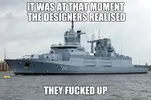The Baden-Wurttemberg’s builder, the
consortium ARGE F125, has tried to downplay the ship’s many problems, saying that some setbacks were not entirely unexpected given that
90 percent of the components on the ship are new and necessarily technologically complex in order to meet the very ambitious German naval mission requirements. For instance, the F125’s multiple mission objectives are to counter “
asymmetric threats” as well as be able to carry out “
stabilization, crisis management, conflict prevention, and international intervention” operations.
To meet these varied missions, the German Navy requires the F125 class frigates to be able to operate and sustain themselves away from home port for up to two years, to operate with a crew of 120 (instead of the 230 on the Bremen class), and to remain at sea some 60 percent of the time (which is double the time of the Bremen class). Furthermore, the F125 frigates are supposed to not only handle a wide range of humanitarian missions, but be able to ferry up to 50 marines into combat anywhere in the world. In addition, the navy requires the F125 design to be highly survivable, as well as possess a small radar cross-section and acoustic signature.
Supporting the frigates’ wide-ranging requirements, especially those involving reduced manning and extended deployment, has created a need for highly integrated shipboard IT systems that must pass stringent reliability and availability benchmarks. Just as important, the Baden-Wurttemberg frigates’ various IT systems are required to support an open architecture to allow upgraded weapons, combat systems, or electronic capabilities to be easily added to meet changing mission needs.
The ARGE F125 consortium
admits that the integrated nature of the frigates’ IT systems, coupled with their strict reliability requirements, has made it difficult to debug hardware and software defects. A consortium spokesperson stated that the “defects are often found at the interfaces between subsystems, which makes their analysis more difficult.” However, the spokesperson says the consortium is confident that the defects will soon be eliminated to allow the lead ship of the Baden-Wurttemberg class to be commissioned later this year, and the others shortly afterwards.
Even if the Baden-Wurttemberg frigates’ problems can be completely eliminated, the U.S. Navy’s experience in trying to reduce ship manning and maintenance through advanced automation suggests that the German Navy will be forced to rethink its F125 crew requirements. A 2017 Government Accountability Office
report [pdf] assessing the U.S. Navy’s multiple attempts to optimize its ships’ manning levels found that the assumption that new technologies would enable smaller crew sizes has been overly optimistic. In fact, “crew sizes on most new ship classes have grown over time as anticipated workload reductions from new technologies have not materialized,” the report states. Expect the German Navy to learn the same lesson.

